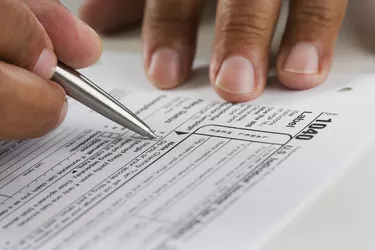
A tax return transcript is like a summary of your taxes, which itemizes, line-by-line, everything on your tax return. It's a very helpful document, but you need to know how to read it, including how to find the refund amount on tax return transcripts. Here is how to decipher this document so you can take advantage of all the information it holds. Don't have a copy of your tax transcript? You can get one from the IRS.
Reading a Tax Return Transcript
Video of the Day
First, verify that all of your basic information is correct, including the spelling of your name and the name of any dependents, address and filing status. Once you've done that, review the section on your income. Make sure that all your sources of income are there, including wages or salary from your job, capital gains, stock dividends, gambling winnings, interest earned and more.
Video of the Day
Apply the same keen eye to the next section on the tax return transcript: your deductions. Make sure the IRS has included all deductions to which you're entitled. These two sections combined are how the IRS determines what you owe.
If you notice any errors on your transcript, contact the IRS immediately. Especially if they have listed more income than what you actually made, you'll pay too much in taxes, but if the amount is under, you could be in danger of an audit. You can also contest some of the charges or taxes you're being asked to pay if you never received the services or think they're incorrect.
Consider also: What Is an IRS Transcript?
How to Read Tax Transcript for Refund Date
You already paid money in taxes throughout the year in your paychecks, and the next section of your return details these. Compare the totals to those listed on your W-2 and any other end-of-year tax documents to ensure they match.
The refund or amount owed section adds all of these sections together. It looks at your total income and amount owed based on that, then subtracts deductions and what you've already paid. If your total is negative, the government owes you a refund. If the figure is positive, that is the amount that you owe.
If you're owed a refund, and you see IRS code 846, it means that your refund has been issued. You can use the cycle code to look up when your refund will be issued. If you used direct deposit, you can plan to see it the following day.
Consider also: How to Interpret Codes in an IRS Account Transcript
FAQs on Tax Return Transcripts and Taxes
What does account balance plus accruals mean? This is relatively simple: it includes any interest earned or other accruals to your account balance. Can students get money back from taxes? They can, even if their parents claim them as dependents. If you earned money working a job of your own and overpaid, you'll receive a refund. However, you cannot accept any other tax credits for your education or living expenses. Your parents or guardians will receive those.
What does tax per return mean? If any of the figures on your return were changed by the IRS, then "per return" means the original numbers you entered on your return. The corrected numbers are labeled "per computer."
What does refundable credits per computer mean? As stated above, the refundable credits "per computer" mean that the original figures on your return ("per return") were incorrect, and the "per computer" refundable credits are the corrected numbers.
Consider also: The Difference Between Tax Transcripts & Tax Returns